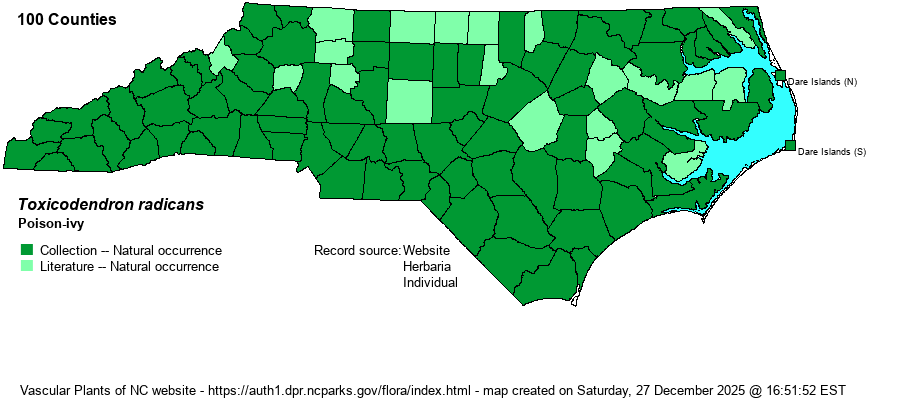| Author | (L.) Kuntze | |
| Distribution | Throughout the state. Occurs in all 100 counties.
Found across southern Canada south to the Gulf Coast, from southern FL to most of TX.
| |
| Abundance | Very common to abundant statewide, less numerous in parts of the eastern Coastal Plain and in the Sandhills. One of the most ubiquitous of our native plants, as everyone knows! | |
| Habitat | The species occurs oppressively in bottomlands and floodplains, and it also is common in other rich wooded sites. It is less numerous in drier swamps, pocosin margins, thickets, and drier woods. It is scarce in higher elevations, and occurs even in dunes and maritime habitats. |
| Phenology | Blooms from late April through May, and fruits from August to October, often persisting into the winter. | |
| Identification | Everyone should know how to identify Poison-ivy. Normally it is a high-climbing vine with adventitious roots, growing far up into tall trees. However, it can also be a strongly rhizomatous shrub, to about 3-4 feet tall. The deciduous leaves have three leaflets, with most showing strong and broad teeth; the leaves are reddish and glossy when young, but later become green and less shiny. Small waxy white “berries” occur in fall; they are important food sources for birds in late fall and early winter. Of course, touching any part of the plant, especially the leaves, can cause severe dermatitis. Even inhaling fumes of burning plants can cause an internal rash. | |
| Taxonomic Comments | Formerly known as Rhus radicans, but this species, along with Poison-oak (T. pubescens) and Poison Sumac (T. vernix), have been moved to the genus Toxicodendron in recent decades. The species has a handful of named varieties, though the one in the state is the nominate one – T. radicans var. radicans. BONAP maps Cumberland County for T. rydbergii, a non-climbing close relative of the North and West, but this record is surely erroneous.
| |
| Other Common Name(s) | Eastern Poison-ivy | |
| State Rank | S5 | |
| Global Rank | G5 | |
| State Status | | |
| US Status | | |
| USACE-agcp | FAC link |
| USACE-emp | FAC link |

